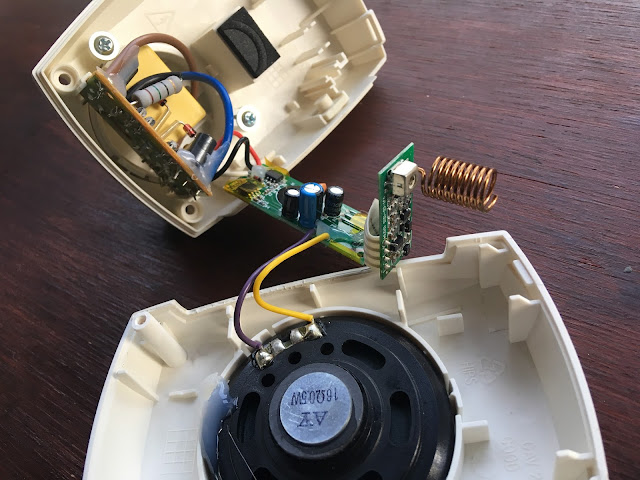Towards a better doorbell...
Something we struggle with as a household is the front door bell. We have a wireless pushbutton at the door, with three (3) separate mains or battery-powered devices listening and responding to make sure there's one in earshot. However, the button's range is limited within the house by walls and other things, so it's hard to make sure a) the responders are in range b) they are close enough for us to hear!
How about a doorbell that sends a text to the phone? Perfectly possible, surely.
Now I need a Twilio account - signed up for the free development account, which also gives me a UK number to send texts from. I might investigate other arrangements at some point, but let's try this out. I need the Account SID and Auth-key to configure the node. The Inject node just sends a canned msg.payload to the Twilio node. After fixing the Account SID (left a digit off!! Discovered this through the Debug panel in the Node RED screen) I get a text message on my 'phone. Wonderful. That was the easy part...
The second message is the Real Thing - the first is the test message sent from the Twilio website.
Here's the doorbell unit slightly dismantled. 433.92MHz receiver obvious, connected to control PCB powered from simple mains -> DC unit. Now, how do I invade this?? My multimeter 9V battery has failed, so I need to get a new one before continuing.
How about a doorbell that sends a text to the phone? Perfectly possible, surely.
- Stick an ESP8266 in the closest responder (mains-powered) that looks for the signal to ring the bell on one of its GPIO pins; this has to be possible surely!
- Have ESP8266 publish an MQTT "front door bell rung" message
- Have a Node RED node listen for this and trigger whatever we fancy on its receipt e.g.
- A text message to one or more phones (handy if we're out, actually)
- An indicator to a camera
- A Klaxon at the back of the house BAR-BAR-BAR ALERT!!
Cool. 1 looks hard at the moment, 2 will be easy once we've got an ESP8266 programmed, so let's have a go at 3 initially - get Node RED to send a text message!
Let's find an SMS Node in the library - I'll go with this one. Installed using npm, after I remembered to change to the ~/.node-red directory!
pi@server:~/.node-red $ npm install node-red-node-twilio
Easy. Restarted node-red (pi@server:~/.node-red $ sudo systemctl restart nodered).
Now there's a new node in the Node RED control panel...
 |
| twilio node in Node RED |
 |
| Dismantled doorbell |
And of course, more research reveals this interesting page from Scargill >sigh<. It discusses using an RFLink 433MHz gateway and an Arduino Mega2560 to pick up and decode 433MHz transmissions into simple text strings sent on a Serial-USB connection. OK, got to have one of those! On its way... I should be able to use all sorts of interesting things from this!
Update
I have been thinking about the construction of this doorbell. It consists of
Update
I have been thinking about the construction of this doorbell. It consists of
- A power supply
- A 433MHz receiver, which I've found just outputs a train of pulses as received from the transmitter
- A single encapsulated chip device, that looks like the stuff one finds in tune-playing/noise-making electronic kids' toys
- A loudspeaker
i.e. there is no obvious separate detection/triggering function, it's all done in the component 3), probably in software. So there's no way I can get to a "ooh, found a valid doorbell push signal" indication, other than tracking the voltage on the speaker! Which is possible, and I might just do it, but there are other things to do, and the RFLink looks more sensible in a generalised way.



How are you going to detect the doorbell button press? I have the same problem, even bought a 433MHz receiver that I've programmed (in Java / diozero) to decode / detect the doorbell signal. Need to look at doing the same in ESP8266.
ReplyDeleteI am currently dismantling the mains powered doorbell responder to see how it works - thinking it will change some electrical state that I can detect, which along with handy mains supply in an ample case, is All Good.
DeleteYou could check out this post, which has an outline of ESP8266 connected to a basic 433MHz receiver... https://tech.scargill.net/rflink-and-node-red/
Delete